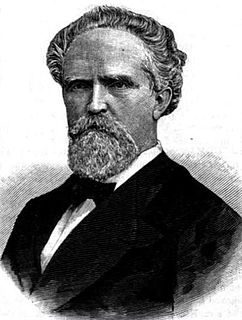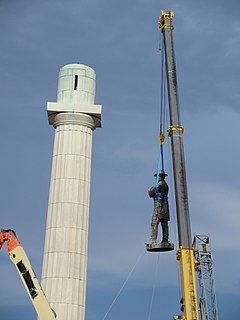
The Battle of Olustee or Battle of Ocean Pond was fought in Baker County, Florida on February 20, 1864, during the American Civil War. It was the only major battle fought in Florida during the war.

Confederate Memorial Day is a holiday observed in several Southern states on various dates since the end of the American Civil War to remember the estimated 258,000 Confederate soldiers and sailors who died fighting against the Union.

John Branch Jr. was an American politician who served as U.S. Senator, Secretary of the Navy, the 19th Governor of the state of North Carolina, and was the sixth and last territorial governor of Florida.

Matt Whitaker Ransom was a general in the Confederate States Army during the American Civil War and a Democratic U.S. senator from the state of North Carolina between 1872 and 1895.

Edmund Kirby Smith was a career United States Army officer who fought in the Mexican–American War. He later joined the Confederate States Army in the Civil War, and was promoted to general in the first months of the war. He was notable for his command of the Trans-Mississippi Department after the fall of Vicksburg to the U.S.

Henry Laurens Mitchell was an American lawyer, judge, and politician. He served as the 16th Governor of Florida (1893–1897).

James Emilius Broome was an American politician who was the third Governor of Florida.

Alfred Holt Colquitt was an American lawyer, preacher, soldier, 49th Governor of Georgia (1877–1882) and two-term U.S. Senator from Georgia (1883–1894), dying in office. He also served as an officer in the Confederate States Army during the American Civil War, reaching the rank of brigadier general.
William Theophilus Dortch was an American politician who served as a Confederate States Senator from North Carolina from 1862 to 1865.

Florida had joined the Confederate States of America in advance of the Civil War, as the third of the original seven states to secede from the Union, following Lincoln's 1860 election. With the smallest population, nearly half of them slaves, Florida only sent 15,000 troops to the Confederate States Army. Its chief importance was in food-supply to the south and support for blockade-runners along its long coastline full of inlets that were hard to patrol.

Thomas Bothwell Jeter was the 79th Governor of South Carolina from September 1, 1880 to November 30, 1880.

George William Dargan was a U.S. Representative from South Carolina, great-grandson of Lemuel Benton.

William Jasper Talbert was a U.S. Representative from South Carolina.

George Dionysius Tillman was a Democratic politician from South Carolina. He was a state representative, state senator, and U.S. Representative. He was the brother of Governor Benjamin Ryan Tillman.

James Montgomery was a Jayhawker during the Bleeding Kansas era and a controversial Union colonel during the American Civil War. Montgomery was a staunch supporter of abolitionist principles and individual liberty and used extreme measures against pro-slavery populations.
Colin J. McRae was an American politician who served as a Deputy from Alabama to the Provisional Congress of the Confederate States from 1861 to 1862.

The display of flags used by and associated with the Confederate States of America (1861–1865) has continued, with a long interruption, into the present day, with the "Southern cross" used in the battle flag of General Robert E. Lee's Army of Northern Virginia gaining the most popular recognition as a modern symbol of the Confederacy, and by extension, the Southern United States in general. Such displays have been made for a variety of reasons, with Southern heritage, states' rights, and historical commemoration among the stated reasons for particular uses. Displaying the flag has long been controversial in the United States, due to the flag's longstanding associations with racism, slavery, segregation, white supremacy, and treason. Many Southerners associate the Confederate battle flag with pride in their heritage and traditions, but for many outsiders it is impossible to separate the flag from its association with the defense of slavery and racial bias.

For decades in the U.S., there have been isolated incidents of removal of Confederate monuments and memorials, although generally opposed in public opinion polls, and several U.S. States have passed laws over 115 years to hinder or prohibit further removals.


















